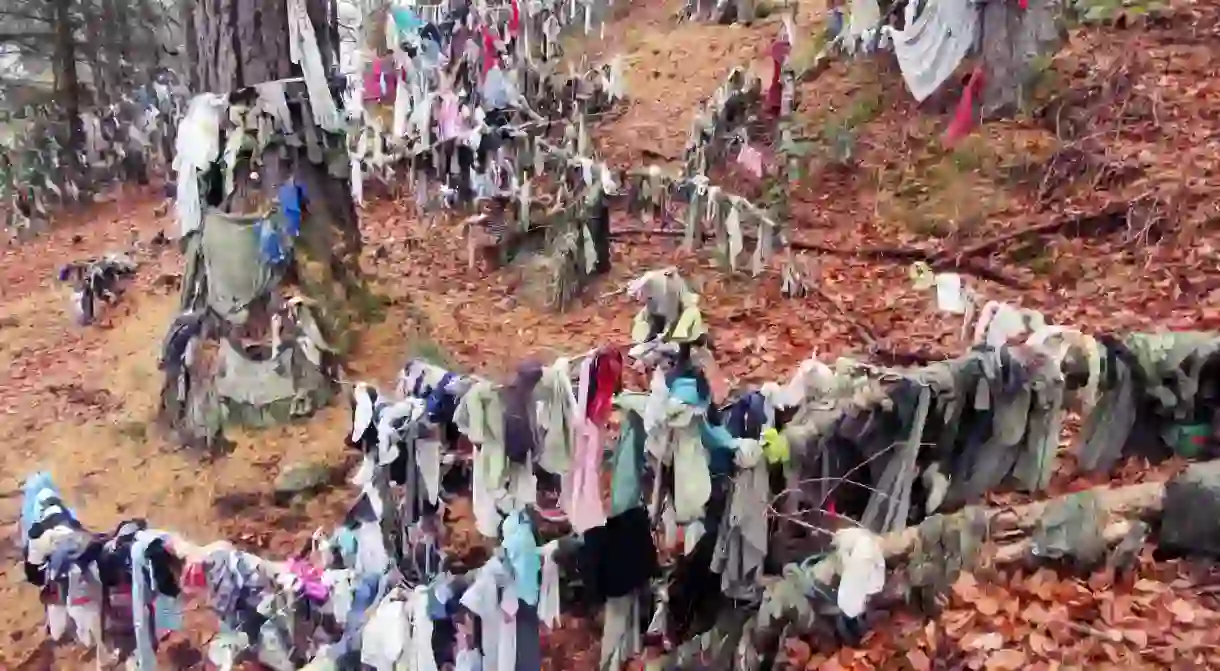Why do Celts Hang Rags on Trees?

There are some traditions that disappear back in time, beyond history. Scotland’s ‘clootie well’ is one of these, with pre-Christian roots potentially stretching back many thousands of years. The best known surviving example is located just north of Inverness, on The Black Isle at Munlochy.
The Scots word ‘clootie’ means ‘cloth’ and this term can also be found in use in the famous Scottish dessert, the ‘clootie dumpling’. The ‘cloots’ of the clootie well are scraps of cloth hung from trees surrounding a sacred well or spring. These sources of clean water have been places of healing for millennia, with ancient Celtic beliefs in spirits and nature being absorbed by the Christian church, and sprites and local gods replaced with saints.

Traditionally, the well would be visited at special times of the year, such as Beltane, the May Day festival of Spring, or when someone needed a cure for an illness. The well would draw people from across the local area, a social pilgrimage, each taking their turn to dip their cloth offering in the water and say a prayer, before affixing it to a tree or bush. Closely linked with good health, the pilgrims would hope for a good year ahead. Those afflicted with an illness or injury would wash an affected area with water from the well, then attach their cloth to the tree, the idea being that as it rotted and faded away so did their affliction.
The Clootie Well is mentioned by several historical writers and collectors of folklore and tradition. Writing in his 1869 Book of Days, Robert Chambers mentioned a well to the east of the current Munlochy site, called Craigach Well, in Avoch. He describes the scene on the first Sunday of May as ‘like a fair’, with English, Scots, and Gaelic all spoken as the pilgrims made their offerings, also noting that each person drank from the well. Thomas Pennant made two famous journeys around Scotland and in 1769 recorded that he saw many such places ‘tapestried with rags’.

Clootie wells are not just present in Scotland, however, with examples being known in Cornwall and Ireland. This suggests a Celtic Iron Age origin for the tradition, although there are other examples of trees decorated with ribbons and scraps of cloth – such as the Evenki people’s ‘Shaman trees’ far away in Siberia, or Tibetan prayer flags – perhaps suggesting an even earlier shared origin. People across the world still hang objects which carry meaning to them, a perfect example being the ‘love locks’ that until recently adorned the Pont des Arts in Paris – a modern phenomenon with echoes of older traditions.

In 1581, Scotland introduced an Act of Parliament which made pilgrimage to a holy well illegal, and the practice began to diminish. The wells to survive this ban were those reassociated with Christian saints, such as Saint Boniface Curitan at Munlochy, and the thousands of visitors to these surviving holy wells were of great financial benefit to both the local church and economy.
Another well, close to Inverness in Culloden Woods, was poignantly decorated with many coloured ribbons and rags when the 51st Highland Division was lost during the Dunkirk evacuations in 1940, demonstrating how an ancient practice still had meaning in recent times.

In today’s world, the predominance of synthetic non-biodegradable fibres, such as nylon, have meant that the cloots are no longer decaying as they once did. The ready availability of cheap clothing has also meant that the cloots are much larger than they traditionally were, with whole items of clothing and children’s toys being tied to the trees. As it is considered very bad luck to remove a cloot, these stay hanging, with the authorities reluctant to remove them.

If you do visit a clootie well, remember to bring your own rags or scraps of cloth to hang; the Forestry Commission recommends you only hang offerings made from wool or cotton.













